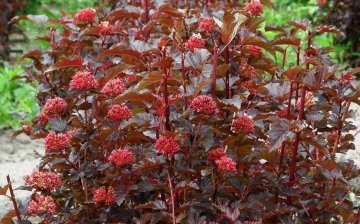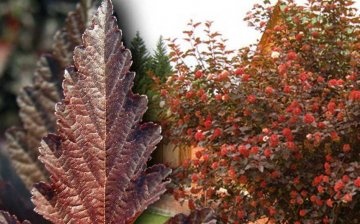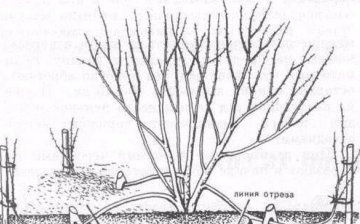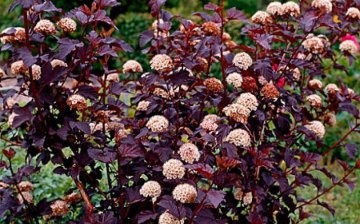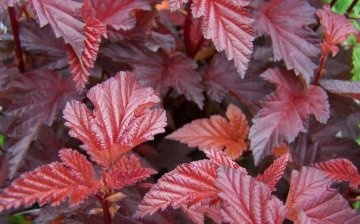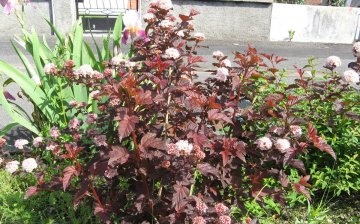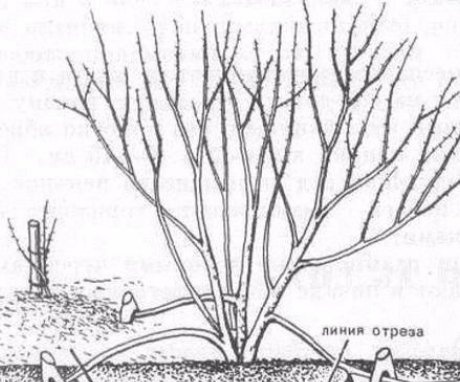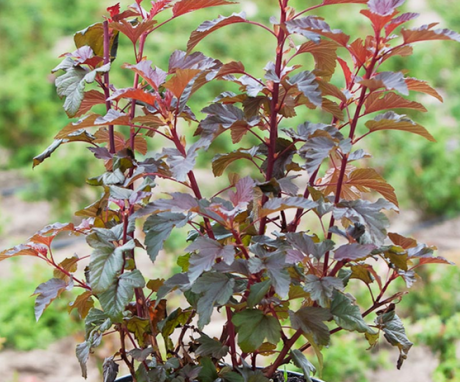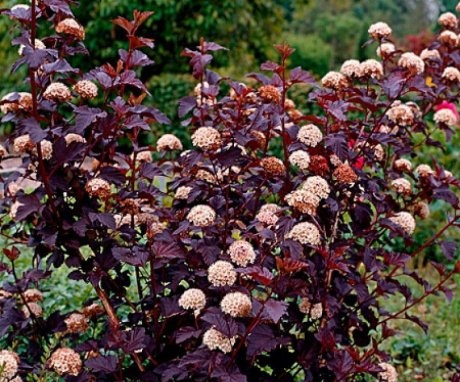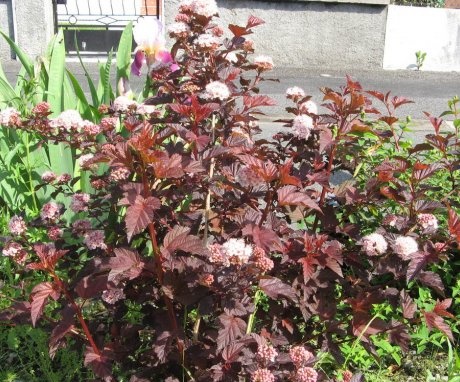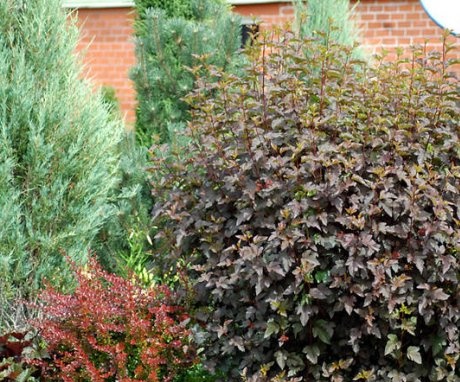Bubble garden Lady in Red: cultivation and application on the site
To give their own garden a unique flavor, some gardeners have resorted to planting colorful exotic plants. Such a unique luxury can be replaced by the viburnum bladder. There are many varieties of this plant in nature, but among the species, the Lady in Red variety stands out for its originality. To plant it on a personal plot, you need to know the advantages of the variety, the rules for its rooting and breeding methods.
Content:
- Description and advantages of the variety
- Breeding method
- Terms and rules for planting a seedling
- Shrub Care Tips
- Pruning and preparing for winter
- Diseases and pests
- Application in site design
Description and advantages of the variety
Lady in Red is a new variety of the viburnum family, developed not so long ago by UK breeders, in 2012. Its name in the translation "Elegant Lady in Red" subtly conveys the whole state of the bush, its unique decorativeness, ease of care and cultivation.
Features of the plant:
- The plant is a miniature bush, reaching a height of no more than 1-1.5 m. The foliage of an adult plant is up to 1.2 m in diameter. Its width and density are regulated depending on the chosen growing method.
- Deciduous plates are a compound of 3-5 blades, somewhat reminiscent of a maple leaf. Greens are oval elongated, the edges have a serrated base.
- The shade of the deciduous cover is red-brown, it gives more to cherry. Has a slightly wrinkled structure, glossy in appearance. When young leaves appear, they are endowed with a red-burgundy tone; as they grow older, they acquire a more saturated dark appearance. By the middle of summer, the tone of the foliage changes to a rich beet color.
- Flowering begins in June. The shrub is completely covered with small pink inflorescences. The flowers mostly gather in small hemispherical clusters, up to 5 cm in diameter. They look spectacular on bright brown foliage.
- Fruit ripening begins towards the end of the last summer month and continues throughout the first month of autumn. When ripe, the fruits do not crumble from the bush, but continue to hang on the branches. Each of them is presented in the form of 4-5, interconnected, swollen leaves. Fully ripe fruits have a reddish brown tint.
Bubble shrub Lady in Red is erect stems, thin in structure. The diameter of each stem does not exceed 2 cm in diameter. The root system of the plant is located on the surface, so the plant requires increased and frequent watering.
The advantages of the Lady in Red variety are increased frost resistance to low temperatures. And also the absence of requirements for the care of the plant and the soil substrate in which the plant will be rooted.
Breeding method
The Lady in Red bubble plant reproduces in only 3 ways:
- Shrub propagation by layering is the most acceptable among gardeners.This procedure allows you to quickly, at no extra cost, get an original plant with a full set of maternal qualities in a short period of time. In addition, during the rooting of the cuttings, the plant is not injured, which does not lead to a loss of vitality. To root a plant, you should first carefully consider the plant and evaluate its capabilities. A healthy stem is selected without visible and internal damage. After that, all the foliage from the vine is removed, leaving only a small green part at the very top of the plant. Next to the bush, a small depression is dug up to 15 cm deep into the soil. The stem is laid inside and fixed with a wooden bracket or other device that will hold the stem well inside the soil. Cover with soil from above, but so that the top of the stem remains on the surface of the earth. Subsequent care consists of constant watering and periodic loosening. It is recommended to carry out a procedure of this kind in the spring. At this moment, the plant has the largest amount of nutrients that can be directed to development. root system... By the end of the autumn months, the plant will have time to take root, release a sufficient number of rhizomes. Now the time has come to detach the young plant from the mother shrub. It is not worth replanting during this period. In the new place, Lady in Red's bubble plant will not have time to take root, which will ultimately lead to the death of a young seedling.
- An equally fast and convenient way - grafting... To do this, you need to choose a suitable stem and cut off one-year-old green branches from it. Place the resulting material in a solution with a root formation stimulator, leave for a short period of time. The next step is rooting. For planting, a mixture of river sand and peat is prepared. After placing in the substrate, the area around the seedling should be thoroughly moistened and a mini-greenhouse should be made. This stimulates the fastest germination of the root system. In the subsequent time, before the onset of frost, the greenhouse should not be removed, it should be periodically opened. This procedure is carried out to ventilate the space and fill the room with fresh air necessary for fast and high-quality growth.
- Reproduction of the plant by dividing the shrub is carried out only in the spring. To do this, the mother bush is dug out of the ground and divided in such a way that on each side there are several growth buds and young stems. After that, along the planned break, the young daughter seedlings are divided into two parts. Fracture points should be sprinkled with activated carbon (crushed) or wood ash. Required for disinfection of an open cut. The next stage is the rooting of each of the obtained seedlings.
Terms and rules for planting a seedling
It is better to plant seedlings in spring due to the fact that during the growing season all living things develop faster and you can observe what is happening. If planting is carried out in the fall, then the event should be held 1-1.5 months before the arrival of a low air temperature. It is required that Lady in Red's vesicle has time to root well at its permanent place of residence, release young roots and extract nutrients and trace elements from the soil.
All gardeners view this procedure differently. Some advise to root the plant in autumn, with a large clod of earth, without injuring the rhizomes. Others, on the contrary, recommend planting in the spring. Each gardener should individually select the optimal placement in the ground. Disembarkation should be carried out in open sunny areas. There should be no tall trees nearby, especially fruit crops. When growing bladder neighboring plants are able to suck out nutritious moisture with powerful roots and be saturated with useful substances intended for a young seedling.
In order for the shrub to have a lush crown, and contrasting inflorescences bloom on the branches, it is necessary to choose the optimal soil substrate.
The soil should be well-drained, loose, allowing both moisture and oxygen to pass deep into the ground to the rhizomes. It is worth choosing a loamy soil substrate, a neutral or slightly acidic pH environment. Fertile land is ideal. It should be prepared by combining river sand, peat, garden soil and sod. All components should be taken in equal proportions.
A recess is prepared for transplantation. It should be 1.5-2 times larger than the soil of the land in which the young seedling is located. The prepared fertile substrate is poured in advance 2-3 weeks before the planned moment of planting the vesicle Lady in Red. During planting, it is necessary to control that the root collar does not sink below the permissible level and does not exceed the required soil level. After planting, the seedling should be shed abundantly. If, after moistening, the earth subsided, then the missing soil is added next to the seedling. To subsequently reduce the amount of watering, the soil next to the base of the bladder plant is lined with mulch.
Shrub Care Tips
A plant from the genus of Kalinolistnyh Lady in Red does not require intensive and specific care. The plant is not a capricious member of the family, but some tips for growing must be followed:
- Adult shrubs are not insulated for the winter. But if they promise a cold winter and without snow, but with frequent frosts, then it is worth insulating the plant first.
- The life cycle of the vesicle reaches 25 years. During the first 4 years, the bush develops and reaches maturity. During the growing season, the vines can grow up to 40 cm. To give a shape and a neat look, the shrub should be periodically pruned.
- Young seedlings require frequent and abundant application of nutrient moisture. Older plants should not be watered often, 1-2 waterings per week are enough for them, being guided by weather conditions. In case of elevated temperatures in summer and lack of rain, nutrient moisture should be applied periodically, even under an adult plant. But do not overmoisten the soil, with stagnation next to the roots of moisture, it is possible to provoke the appearance of the vesicle on the branches powdery mildew.
- The bush is favorable to feeding. It should be fed at the beginning of the growing season with nitrogen-containing preparations. It is also worth carrying out fertilization before retirement, in the fall.
Thanks to the simple rules of care, growing a plant is not difficult. The main thing is to water on time, periodically carry out loosening, which allows you to prevent weeds from developing. Additionally, loosening is necessary in order to eliminate the dense crust formed near the base of the root after watering. This leads to a lack of oxygen supply to the rhizomes.
Pruning and preparing for winter
To form a beautiful dense crown, it is necessary to periodically prune the bush. Removing unnecessary overgrowth is a normal procedure for the vesicle. Such an event makes it possible to form any shape from a plant, creating a hedge or curb bushes.
The development of the plant and its growth depends on the procedure, how correctly it was performed. Every year, both sanitary and formative pruning is carried out for the plant. For this, the following rules are followed:
- Sanitary pruning involves removing any branches that have been broken, damaged, or bruised by disease. The procedure is carried out in the spring months or as needed.
- Formative pruning is carried out only after the flowering period.The stems are shortened by 1/3 or Ѕ of the entire vine.
- For the formed hedge from the bladder, it is necessary to prune no more than 1-2 times during the summer.
- The primary haircut is carried out in the last days of April or in the first decade of May. At this time, the plant has already started to grow, but has not yet had time to fully open the buds. Thanks to this, you can see where the trunk needs to be cut and where it is worth leaving.
- With the aging of the shrub, rejuvenating pruning is carried out. Some gardeners recommend gradually eliminating old branches, others advise cutting off everything at once, giving the young growth the opportunity to quickly grow and develop.
For the winter, the plant, no matter how it was planted, should be wrapped in foil or other covering material. This is required so that the fragile bush does not freeze with a strong drop in temperature. From above, when snow falls, it is required to pour a large snowdrift. It will keep the soil warm and protect it from frost and strong winds.
When spring comes, the covering material is removed. It is necessary to control the moment of removing the film. Condensation inside the film stimulates the appearance of a fungal disease. Therefore, when a positive temperature is established and the onset of the first warm days, you should immediately open up young bushes. After the overwintered bush can be transplanted to a new place of residence.
Diseases and pests
The gallbladder is almost never exposed to the appearance of harmful parasites and the development of pathogenic bacteria. But if moisture stagnates at the base of the root system for a long period, powdery mildew may appear on the foliage of the plant. Which is hard enough to get rid of. We'll have to use chemical fungicides.
In another situation, with a lack of nutrients, there is the possibility of developing chlorosis. It is formed when there is a shortage of magnesium and iron in the soil. In such a situation, yellowing of the leaf plates occurs throughout the shrub. In the absence of treatment with chemicals, Lady in Red's vesicle gradually begins to dry out, the leaves completely dry out and fall off the stems.
The lost health of the plant can be restored by introducing a solution saturated with iron under the root. This effect is carried out using Antichloroz, Ferrylene or Ferovit.
Application in site design
In most cases, Lady in Red's vesicle is used as a hedge. Its dense, dense stems are so close that they form an impassable hedge. At the same time, the bright color of the leaf plates makes the plant a highlight of any composition and whether a separate section of the garden.
The shrub grows easily in any climatic zone, even with poor ecology, therefore it is often planted in curbs near roads.
The plant looks interesting in single plantings, surrounded by a calm flower bed of neutral flowers or in combination with evergreens. This allows you to focus all attention on the vesicles, showing its original catchy beauty.
Bubble often used in finishing works. It looks effective in the main places, for example, the entrance to the park area. In addition, the plant is often decorated with city streets, squares and parks. They are designed to be both a central part in a species flowerbed, and they are a specific hedge that separates one territory from another. In some cases, especially experienced gardeners create bizarre mazes with the help of a plant.
Thus, Lady in Red's vesicle is an interesting new plant from the Vine-leaved family tree. For its propagation, seeds should not be used; it is better to grow a young seedling using cuttings or cuttings. The main thing is that after rooting, you should take care of the growing seedling.In winter, it is recommended to cover the sprout without fail so as not to destroy the young sprout.
More information can be found in the video:



